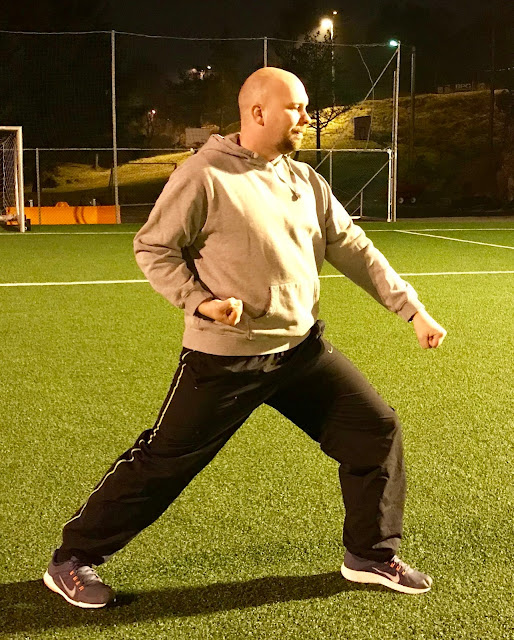Before we begin you might also want to check out my thoughts on what "Makki" actually means in English, as I think "Block" is a very crude and simplified translation.
First we have an Arae Makki (Low section defensive technique) in an Ap Seogi (Short front walking stance) used as a wrist grab defense. I usually teach this as the first "alternative application" because the application depends on a good solid traditional basic technique, chamber, pulling hand back to the hip and all. While a deflection is a valid application, it fails to explain the whole movement, and so students fail to practise the basic template (basic technique) as it is supposed to be done. They tend to over-emphasise the "blocking" arm, and de-emphasise the chamber, pulling hand back to the hip and so on. This is not strange as the deflection that is often taught makes no use of anything other than the "blocking arm" coupled with evasion. The following wrist grab release would be a great replacement, simply because it makes use of the whole movement and it can be used in a less rules restricted environment. What do you do if someone grabs your wrist? Do an Arae Makki :-) Problem solved. What do you do if you get a wrist grab defense as part of your grading but you get log jam in your brain and you do not remember how to free yourself? Do an Arae Makki, problem solved. What if you are grappling and you do a groin grab, but the opponent grabs your wrist so you have to free yourself so you can continue striking? Do an Arae Makki and problem solved. Contextualise it later, the basic template and the basic practical application is as follows:
 |
| Solo basic template, "chamber" |
 |
| Solo basic template, arae makki "block" |
 |
| Wrist is grabbed, do the chamber (this also positions your arm to protect your head. |
Another application that I teach for the Arae Makki is as an elbow joint lock. I emphasise then that the stance is a short stance in the first application so you can keep moving into the opponent to continue striking, while here the stance is a low front stance to get the weight into the lock. So even though the basic template of the Arae Makki is the same, the application is different because of the stance. If you have been working on applications yourself you might note that doing the above application as a wrist grab release can just as easily be done dropping into the long front walking stance as well, the follow up options are a little more limited because the stance makes you a lot closer. Again, different Poomsae combinations will demontrate different follow ups and variations, so feel free to explore this in the future, but for the ABC's just making the students aware that the stance is itself a vital part of the application is more than enought as a solid starting point.
 |
| Solo template, "Chamber" |
 |
| Solo Template; "Block" |
From the previous position, drop into a front stance while applying pressure against his elbow joint, straightening his arm by pulling it back to your hip. This is the application of the "block" itself.
I hope you found this interesting, and I will follow this post up in the upcomming weeks so you can build upon the lessons learned in this post :-) Stay tuned.
from Traditional Taekwondo Ramblings https://ift.tt/2TzDJhe




No comments:
Post a Comment